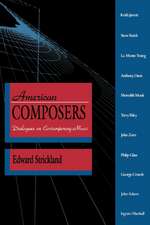Minimalism:Origins
Autor Edward Stricklanden Limba Engleză Paperback – 21 sep 2000
The term Minimalism appeared in the mid-1960s, primarily with reference to the stripped-down sculpture of artists like Robert Morris and Donald Judd, both of whom detested the word. In the late 1970s it gained currency when applied to the repetitive music popularised by Steve Reich and Philip Glass.
In the first part of the book; Paint, Strickland shows how Minimalism offered a rethinking of the main schools of abstract art to mid-century. Within Abstract Expressionism Barnett Newman opposed the stylistic complexity of confessional action painting with non-gestural colour-field painting. Ad Reinhartdt and Ellsworth Kelly reconceived the rhythmic construction of earlier Geometrical Abstraction in "invisible" and brilliant monochromes respectively and Robert Rauschenberg created Dadaist anti-art in pure white panels.
Next, Strickland surveys Minimal music, from La Monte Young's long-tone compositions of the 1950s to his drone works of the Theatre of Eternal Music. He examines the effect of foreign and nonclassical American music on Terry Riley's motoric repetition, developed from his tape experimentation Steve Reich's formulation of phasing technique and Philip Glass's unison modules.
The third part of the book treats the development of Minimal sculpture and its critical reception. Strickland also discusses analogous Minimalist tendencies in dance, film, and literature, as well as the incorporation of once-shocking Minimalist vocabulary into mass culture, from fashion to advertising.
Investigating the origins of Minimalism in post-war American culture, Strickland redefines it as a movement that developed radically reductive stylistic innovations in numerous media over the third quarter of the 20th century.
Librarul mai recomandă
Preț: 200.17 lei
Nou
Puncte Express: 300
Preț estimativ în valută:
38.31€ • 39.85$ • 31.62£
38.31€ • 39.85$ • 31.62£
Carte tipărită la comandă
Livrare economică 15-29 aprilie
Preluare comenzi: 021 569.72.76
Specificații
ISBN-13: 9780253213884
ISBN-10: 0253213886
Pagini: 320
Ilustrații: 1, black & white illustrations
Dimensiuni: 154 x 233 x 21 mm
Greutate: 0.54 kg
Editura: MH – Indiana University Press
Locul publicării:United States
ISBN-10: 0253213886
Pagini: 320
Ilustrații: 1, black & white illustrations
Dimensiuni: 154 x 233 x 21 mm
Greutate: 0.54 kg
Editura: MH – Indiana University Press
Locul publicării:United States
Cuprins
Paint
Sound
Space
End
Bibliography
Index
Sound
Space
End
Bibliography
Index
Recenzii
. . . a landmark work, the first attempt to write a pre-history of minimalism that embraces all the arts. Its importance cannot be overestimated." --K. Robert Schwarz, Institute for Studies in American Music
"All told, this book is mandatory reading for anyone who wishes to understand the history and nature of minimalism." --i/e NINE
"All told, this book is mandatory reading for anyone who wishes to understand the history and nature of minimalism." --i/e NINE
Textul de pe ultima copertă
""The death of Minimalism is announced regularly, which may be the surest testimonial to its staying power."" This is the opening sentence of Edward Strickland's study, the first to examine in detail Minimalist tendencies in the plastic arts and music. The term Minimalism appeared in the mid-1960s, primarily with reference to the stripped-down sculpture of artists like Robert Morris and Donald Judd, both of whom detested the word. In the late seventies it gained widespread currency when applied to the repetitive music popularized by Steve Reich and Philip Glass. In the first part of the book, ""Paint,"" Strickland shows how Minimalism offered a rethinking of the main schools of abstract art to mid-century. Within Abstract Expressionism Barnett Newman opposed the stylistic complexity of confessional action painting with non-gestural, color-field painting. Ad Reinhardt and Ellsworth Kelly reconceived the rhythmic construction of earlier Geometrical Abstraction in ""invisible"" and brilliant monochromes respectively; and Robert Rauschenberg created Dadaist anti-art in pure white panels. Next, Strickland surveys Minimal music from La Monte Young's long-tone composions of the fifties to his drone works of the Theatre of Eternal Music. He examines the effect of foreign and nonclassical American musics on Terry Riley's motoric repetition developed from his tape experimentation, Steve Reich's formulation of phasing technique; and Philip Glass's unison modules. The third part of the book treats the development of Minimal sculpture and its critical reception. Strickland also discusses analogous Minimalist tendencies in dance, film, and literature as well as the incorporation of once-shocking Minimalistvocabulary into mass culture from fashion to advertising. Investigating the origins of Minimalism in postwar American culture, Strickland redefines it as a movement the developed radically reductive stylistic innovations in numerous media over the third quarter of the twentieth century.
Descriere
The beginnings of minimalism in music and the visual arts.

















